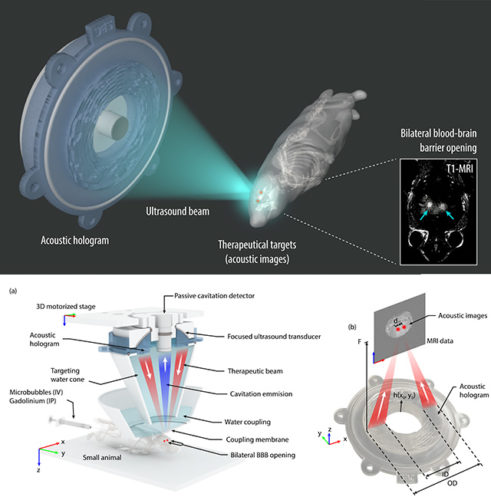Sergio Jiménez Gambín is a recipient of the Relevant Doctoral Thesis Awards granted by the Higher Council for Scientific Research (CSIC, for its Spanish initials). This award “has given me the motivation to continue pursuing my research dream; to develop a technology capable of treating Alzheimer’s disease.”
Jiménez Gambín studied the Master’s Degree in Acoustic Engineering at Campus Gandia of the Universitat Politècnica de València (UPV). Subsequently, he went on to the PhD Program in Technologies for Health and Well-being, also at the UPV, where he has completed his doctoral dissertation based “on the use of ultrasonic holograms for drug delivery to the brain, and thus enable the treatment of Alzheimer’s, Parkinson’s or brain tumors.” The thesis was directed by Francisco Camarena, a professor at Campus Gandia (UPV) and Noé Jiménez, both researchers at the Institute of Instrumentation for Molecular Imaging (I3M).

A Promising and Innovative Technology
“Traditionally, drug delivery to the brain has been limited for two reasons. Firstly, the blood-brain barrier (BBB) is a natural protective mechanism that restricts the access of certain harmful molecules and protects the brain tissue. But unfortunately, it also limits the passage of drugs for the treatment of brain diseases. Secondly, the skull also acts as a shield, covering the entire brain, and you have to get through it somehow to get to the diseased brain tissue.” For this reason, “the use of focused ultrasound and the injection of microbubbles into the bloodstream enables the opening of the BBB and, therefore, the delivery of drugs, since it is a non-invasive and safe technology for the patient.”
This proposal, focused on the use of ultrasonic holograms “printed in 3D, allows for aberrations in the skull to be corrected, thus providing a very precise opening of the BBB, specifically in the brain areas to be treated.”
In the last two decades “two methods have been used to generate ultrasound beams. On the one hand, the single-element emitter is very simple and inexpensive, but the wave propagated through the skull is distorted and has undesired effects, so the BBB opening lacks precision and effectiveness. On the other, there is the multi-element emitter, which can correct the effects of the skull using multiple emitters that adapt the phase-amplitude wave parameters to each patient, thus achieving a highly controlled opening, but at a much higher cost.”
Therefore, “the objective is the use of a single-element emitter, but with an ultrasonic hologram coupled in front of said emitter. In this way ,the hologram itself is responsible for modifying the characteristics of the transmitted wave, resulting in a very precise and localized BBB opening, but at a much lower cost, casting itself as a promising and innovative technology that could revolutionize the biomedical field.”

Ultrasound and Elasticity Imaging Laboratory
Currently, Sergio is a postdoctoral researcher at the Ultrasound and Elasticity Imaging Laboratory (UEIL) at Columbia University, continuing his research on the use of holograms. But, on this occasion, “applied in large animal models in (monkeys) with the ultimate goal of using them clinically in humans.”
Fuente: Laida Frasquet Pascual, periodista del Área de Comunicación de la UPV

